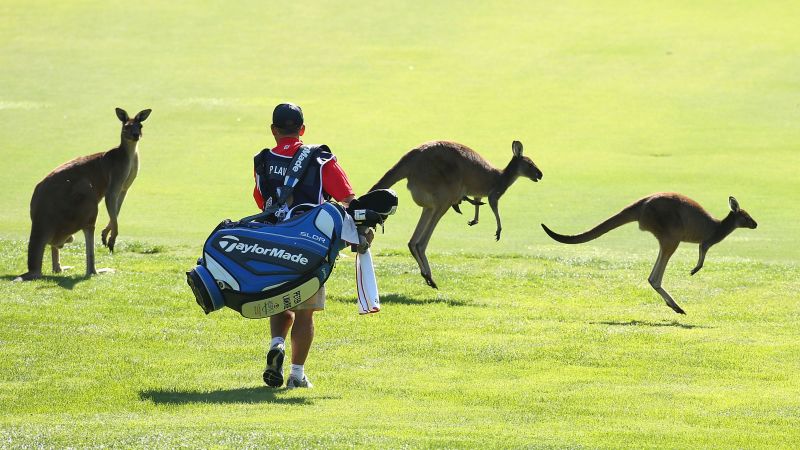A ball flies down the fairway, watched by a mob of kangaroos with passing interest.
In a nearby water hazard, a three-and-a-half-meter long crocodile swims lazily by. On the green, a venomous snake uncoils out of the hole and slithers away into the long grass.
The golfing experience in Australia can be – quite literally – a different beast. In a country teeming with wildlife, the sprawling expanses of its myriad courses offer ideal habitats for an array of land-based, aquatic, and airborne species.
A strong wildlife presence does not make Aussie golf unique: the histories of professional events being interrupted by various creature cameos – from squirrels to seagulls and deer – are well-documented.
Few countries, however, boast a range of animals as dangerous as Australia, a reality that poses challenges to the courses that many of them call home.
‘Roos in the rough
Thankfully, one species of the nation’s most iconic animal is very little trouble at all, even for a course that accommodates hundreds of them.
More than 300 Eastern Grey kangaroos enjoy total freedom of movement at Anglesea Golf Club, situated on the Great Ocean Road along Victoria’s stunning southern coastline, an hour’s drive from the center of Melbourne.
The hopping marsupials were the original residents of the area, with the farmer only selling the land for the course – opened in 1953 – on the condition that the kangaroos would be allowed to keep living there.
Seventy years on, the course remains teeming with ‘roos. It’s a reality fully embraced by the club, which runs a popular kangaroo bus tour to give visitors a deeper insight into the lives of its beloved locals.
“Because they sit up, scratch themselves and use their ears very expressively, people relate to them so easily and quickly … they’re a little bit human.”
Yet the kangaroos may actually require less upkeep than people, effectively “managing themselves,” Lacey added.
With no fences around the course’s perimeter, the ‘roos can roam as they like, free to venture off into the surrounding bush and streets. This typically only applies to males however, as females and joeys (young) tend to stay rooted to a particular spot on the course.
The occasional narrow footprint in a bunker is the extent of damage. As vegetarians, the kangaroos exist on a diet of grass – predominantly the longer type around the course’s edges – bark, and leaves.
A potential poo problem is naturally solved by mowers spreading the manure around, providing free fertilizer for the fairways. If a ball does settle in a sandy footprint, players are afforded a drop.
The club provides only two broad guidelines regarding its kangaroos, such is their docile nature: no feeding and no petting. Regular players are well-accustomed to their presence, knowing they need to move the ‘roos from the fairway if they tend to be a low-hitter.
That can be easier said than done. The course’s kangaroos have no interest whatsoever in golf balls and are so comfortable around people that they often won’t move unless players get within a meter.
Arm waving and vocal cues are likely to be met with a blank stare, but the flap of a golf umbrella has been found to be an improvised fix for getting the kangaroos to move if they’re at risk of being hit.
Because even if the kangaroos don’t care about the golfers, the golfers care deeply about the kangaroos.
“The players never tire of the ‘roos,” Lacey said.
“If there’s a baby just coming out or having a little jump, you just stop playing and watch that with your mouth open, even when you’ve seen it hundreds of times.
“They are infinitely fascinating and players just love them.”
Water hazards
There is no need for a no-petting rule for other animals that commonly inhabit Australian golf course – chief among them, crocodiles.
The country’s warmer northern states of the Northern Territory and Queensland serve as ideal habitats for saltwater crocodiles, known locally as “salties,” which can grow up to six meters (19 feet) in length. There are thought to be more than 100,000 saltwater crocodiles in the Northern Territory, according to regional government estimates.
Queensland’s cooler temperatures make it less of a croc hotspot than the Northern Territory, yet their presence in the state’s waterways remains a daily – frequently dangerous – reality. In May alone in Queensland, human remains were found inside a crocodile; weeks later, a snorkeler survived a saltie attack by prizing its jaws off his head.
It brings a new meaning to the term ‘water hazards’ at Queensland’s various golf courses, including Half Moon Bay Golf Club near Cairns, situated on the state’s north-eastern tropical coastline and carved out of the thick coastal scrub between the Coral Sea and swathes of rainforest-covered mountains.
It’s a course humming with wildlife. Overhead, there’s a sprawling array of birdlife, from the vibrant crimson finches of the lagoon grasses to the great-billed herons that wade among the mangroves. Underfoot, snakes, including pythons and venomous taipan and brown species, and lizards, specifically monitors and goannas, explore the long grasses.
Turtles and a range of fish frequent the course’s various waters, but of all the animals around the course, it’s the crocodiles who draw in the crowds.
“Crocodiles seem to be a tourist drawcard and people want to see them. Other animals, turtles and birds etc., are welcomed sightings but not something that seems to draw people to our venue.”
Operating in the course’s favor is a “crocwise” nature built into the majority of the club’s players. The Queensland government’s guidelines, such as standing back from the water’s edge when fishing and never feeding crocodiles, have become common-sense for locals.
Crocodile sightings can be reported to local rangers via an app, online, or by mobile. If it is declared as a “problem” crocodile – based on its location, size and behavior – it is targeted for removal with the aim of relocating it to a licensed zoo or and farm.
The last big crocodile to be removed by rangers from Half Moon Bay was in 2019. Despite their enduring popularity at the course, daily sightings remain a novelty.
Yet vigilance remains essential, especially for the two groups most at risk: those unaccustomed to the dangers of the local wildlife, and those searching for golf balls away from the open fairways and greens.
“The challenges are specific to risk management,” Mackrill added. “We have a number of inquisitive patrons that are not adverse with the dangers some of this wildlife.
“Complacency during a round of golf also can lead to some dangers, (if) players put more attention into searching for their golf ball then the potential of being close to a hidden animal.”
Hissing hole
Sometimes though, it’s inquisitive wildlife that brings potential danger to patrons.
Amanda Jayne is a member of The Coast Golf Club, a links course perched on the sea cliffs of Sydney’s stunning coastline. In June and July, golfers will frequently putt to the backdrop of humpback whales and their calves mid-migration.
On one blistering Saturday in January though, the spectacle was front and center.
Waiting for her friend to putt, Jayne was holding the 2nd hole flag when she noticed a chrome black shape, four feet long, slithering across the green towards her.
The visitor was a red-bellied black snake, a venomous – albeit generally shy – species of the elapid family native to Eastern Australia.
Jayne’s playing partner, terrified of snakes, bolted. Yet Jayne stayed just long enough to put the flag back in before the snake eased into the cup and coiled itself around it. Showing no sign of aggression, the serpent kindly poked its head out for a photo opportunity.
“But I was calm, just put the flag back in. It wasn’t until after the event when I thought, ‘Oh my god, I just came that close to a red bellied-black.’”
The snake was so tightly tucked in that it could not be seen from eye level, so Jayne’s group alerted the clubhouse and continued with their round. A few holes later, it disappeared back into the bush.
Several more of the snakes have been spotted since, but while caution is required, they are often a welcome sight. Red-bellied blacks prey on eastern brown snakes, a highly-venomous, more aggressive species that – should the grass be scorched or cut too low – can effectively become “invisible.”
For Jayne, originally from England, it’s simply par for the Aussie golf experience.
“You live in Australia, and they [dangerous wildlife] all live here,” Jayne said.
“It doesn’t matter whether you’re on a golf course, whether you walk in bush lands – wherever you are, you know they’re there, you just have to be cautious.”






